My single line text
My single line text
My single line text

"MANUALE DI VOLO"
COPENHAGEN, ArtNordic 2019, Lokomotivvaerkstedet April 5th - 7th, 2019
March 26th, 2019

Andrea Fallini
I went to the BZanconato’s studio to have an anticipation of her new show “MANUALE DI VOLO" ("Flight manual") she will present to the Lokomotivvaerkstedet in Copenhagen during ArtNordic 2019. “In this show I have wanted to speak about love. In reality, it is difficult to speak about abstract concepts as love because proper and enough words to describe all the possible facets and declinations of this feeling don't exist. Words, in these cases, rather than to communicate, rather than to serve as a bridge, becomes barriers. Feelings have to be lived, to be tried. Defining an abstract concept you never arrive to be exhaustive”, the artist anticipates me before showing the works on which she is still affixing the latest retouches.
She adds: ”The starting point of my reflection is the desolation that sometimes you feel in front of certain situations or to facts with which, in a way or another, you come to contact. And the question that has risen has been: why in the world there is more hate (or indifference) than love?”.
She adds: ”The starting point of my reflection is the desolation that sometimes you feel in front of certain situations or to facts with which, in a way or another, you come to contact. And the question that has risen has been: why in the world there is more hate (or indifference) than love?”.
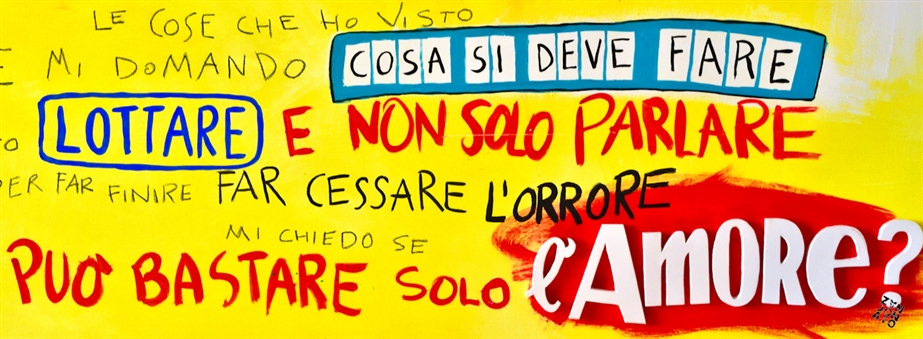
She takes me in front of a big artwork “COSE CHE HO VISTO” (“Things I have seen”): ”This artwork is my transposition of the Eros Ramazzotti’s homonymous song. The last verse reassumes particularly the question I asked me: «… to make end, to make stop the horror can be enough love only ?» In other words I have wanted to face the matter from a different perspective, it almost dealt with a social phenomenon because, after all, the point could be really this... In substance, love for me is a form of energy."
BZanconato explains me that, in her vision, the question starts from quite far: from the relationship with yourself. “Everyone of us – she says- is like a seed of a flower that tries to take root, to develop and to bud. Only in the moment in which it buds it can spread in the world its perfume (that is, going out of metaphor, it can fully love). To bring your destiny to conclusion, that is to make to bud the flower that will develop from the seed that it’s inside you, it implies and needs to know what kind of flower you are destined to be."
So, for the artist it's very important to look inside yourself, to go deep in your own sensations, to analyze your own feelings and states of mind: to become like an observer of yourself, not only to know yourself but also to acquire that awareness with which you can withstand the influences and the pressures of the environment that surround you. But this is not a widespread exercise. On the contrary, you are pushed by the society to assume the role of a consumer chasing new means to appear keep up with fashions and times. This uncritical and unconscious assumption of behavioral models proposed by media and publicity it doesn't do nothing but to defraud deceitfully the individual of his true personality. The person, without a suitable education of the mechanisms of medias and without a suitable educational and psychological support aimed to strengthen his individuality and self-esteem, finds the answer and the defense from the sense of inadequacy, from the fear and from the loneliness in the annulment of his own nature and in the conformism. Thus, the purchase and the possession become the key actions to resolve the problem of his loneliness and to answer to the fundamental question: who am I?
Unfortunately this way to acquire safety and to belong to a group doesn't appease but rather amplifies the sense of void that many feel.
BZanconato explains me that, in her vision, the question starts from quite far: from the relationship with yourself. “Everyone of us – she says- is like a seed of a flower that tries to take root, to develop and to bud. Only in the moment in which it buds it can spread in the world its perfume (that is, going out of metaphor, it can fully love). To bring your destiny to conclusion, that is to make to bud the flower that will develop from the seed that it’s inside you, it implies and needs to know what kind of flower you are destined to be."
So, for the artist it's very important to look inside yourself, to go deep in your own sensations, to analyze your own feelings and states of mind: to become like an observer of yourself, not only to know yourself but also to acquire that awareness with which you can withstand the influences and the pressures of the environment that surround you. But this is not a widespread exercise. On the contrary, you are pushed by the society to assume the role of a consumer chasing new means to appear keep up with fashions and times. This uncritical and unconscious assumption of behavioral models proposed by media and publicity it doesn't do nothing but to defraud deceitfully the individual of his true personality. The person, without a suitable education of the mechanisms of medias and without a suitable educational and psychological support aimed to strengthen his individuality and self-esteem, finds the answer and the defense from the sense of inadequacy, from the fear and from the loneliness in the annulment of his own nature and in the conformism. Thus, the purchase and the possession become the key actions to resolve the problem of his loneliness and to answer to the fundamental question: who am I?
Unfortunately this way to acquire safety and to belong to a group doesn't appease but rather amplifies the sense of void that many feel.
To quote E. Hillesum, so dear to the artist, “It’s enough a misunderstanding of a certain gravity and we immediately become insecure and we lose the ground beneath our feet. Because we were not worried about to build enough solid foundations.”
The artist brings me in front of a human head of chalk, broken near the cranial cap; beside a metal box containing several tens of drawings on paper.
“In Copenhagen - BZanconato explains - I will prepare an installation entitled “L’OSSERVATORE INTERNO” ("The Inside observer"). The drawings are the representation of the emotions, of the feelings, of the humors that daily emerge in my mind. Reflecting on my feelings and on everything I feel, it has helped me and it helps me to understand who really I am. This releases me, little by little, from that conditionings that I have somehow suffered and that don't belong to me. Listening to what I feel, without prejudices or censorships, I have learned, with my times, to be myself, to perceive what it's me more kin and what's me more distant. This, from time to time, seems to show me a direction. At the same time I have acquired conscience of me, I have grown stronger learning to face the different situations aware that these are as momentary clouds ".
BZanconato explains me the meaning of this artwork in the general context of the show: to know and love yourself are the presuppositions to love the others and to live life in every aspect, knowing that it can reserve beautiful moments but also painful. In the modern society, however, and then, still more, in that contemporary, it is not important to be: it's important to have for appearing (according E. Fromm and Z. Bauman).
So, if, on one side, the time for the care of your own physical wellness has entered the daily routine, the same is not for that of your own inner part.
The artist brings me in front of a human head of chalk, broken near the cranial cap; beside a metal box containing several tens of drawings on paper.
“In Copenhagen - BZanconato explains - I will prepare an installation entitled “L’OSSERVATORE INTERNO” ("The Inside observer"). The drawings are the representation of the emotions, of the feelings, of the humors that daily emerge in my mind. Reflecting on my feelings and on everything I feel, it has helped me and it helps me to understand who really I am. This releases me, little by little, from that conditionings that I have somehow suffered and that don't belong to me. Listening to what I feel, without prejudices or censorships, I have learned, with my times, to be myself, to perceive what it's me more kin and what's me more distant. This, from time to time, seems to show me a direction. At the same time I have acquired conscience of me, I have grown stronger learning to face the different situations aware that these are as momentary clouds ".
BZanconato explains me the meaning of this artwork in the general context of the show: to know and love yourself are the presuppositions to love the others and to live life in every aspect, knowing that it can reserve beautiful moments but also painful. In the modern society, however, and then, still more, in that contemporary, it is not important to be: it's important to have for appearing (according E. Fromm and Z. Bauman).
So, if, on one side, the time for the care of your own physical wellness has entered the daily routine, the same is not for that of your own inner part.
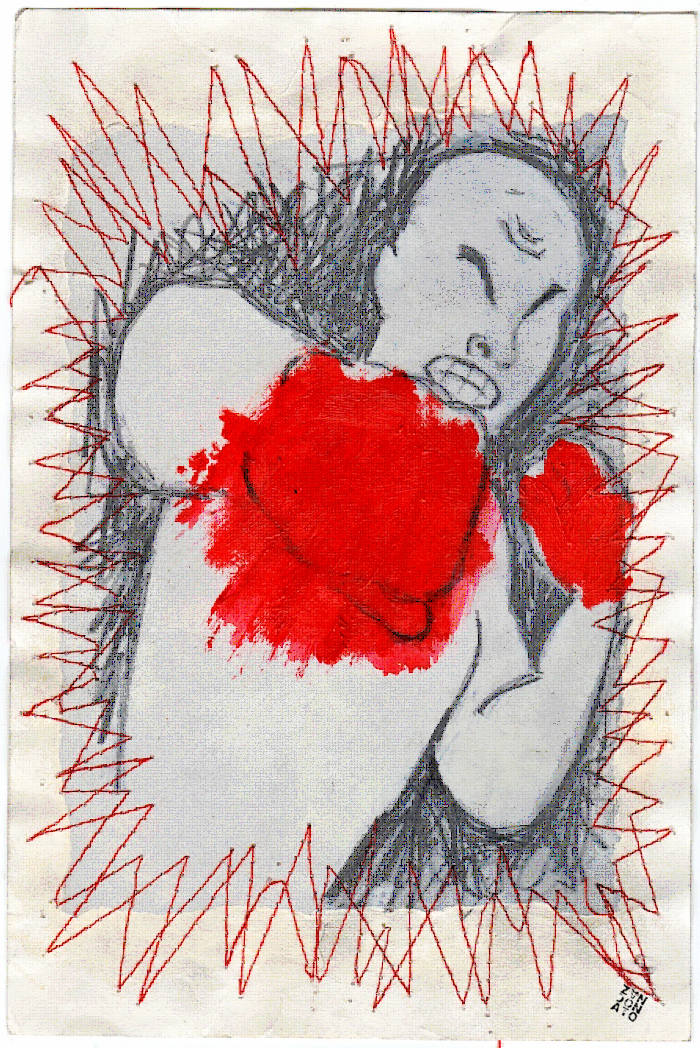
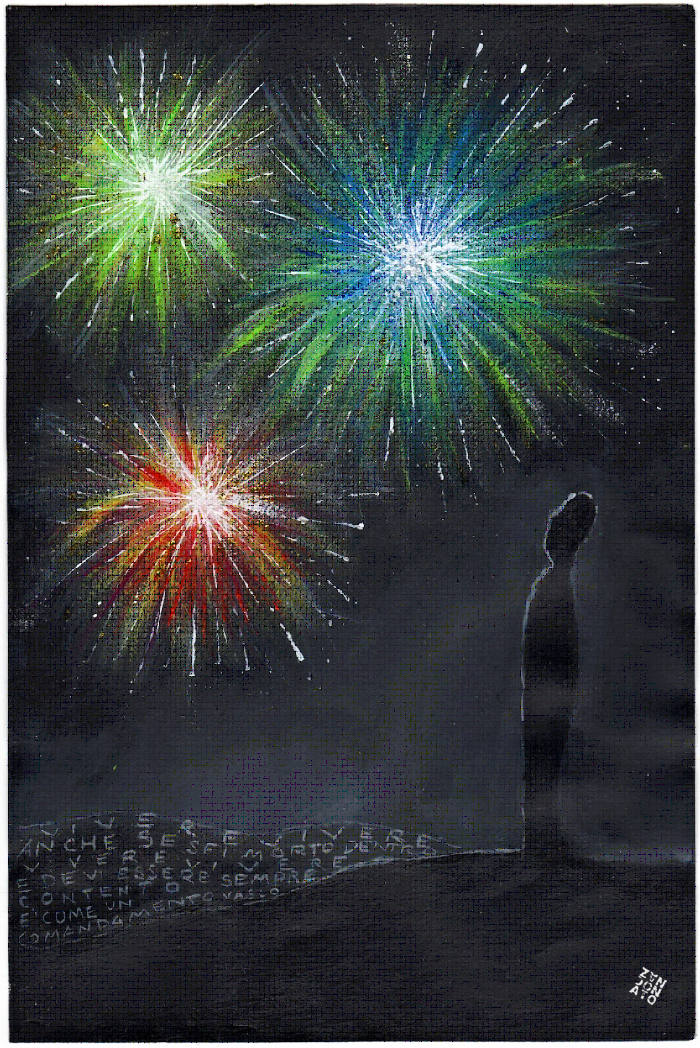
“L’OSSERVATORE INTERNO”represents really this: an invitation to take care of your own inner component. This invitation passes through the sincere and direct example offered by the artist that shows what means to pay time and attention to your own emotions and deeper feelings, with honesty and without censorships. Through her experiences, she shows that, in the soul, motions of all the types take shape and that, especially in certain situations, the most painful feelings take over. Those feelings that education and current mentality would want that they were ignored, deleted.
On the contrary, the sense of loneliness, the discouragement, to feel a fish out of the water, to feel fighting with the world, the sense of the time that escapes, the desire of escape, … because they underline the everyone's difference from the image that the world would want, they represent the voice of the inwardness. These emotions are often detectors of needs asking for an answer; they are, in other cases, detectors of a process that potentially is ready to be triggered.
Symbolic, to this respect, the quotation of E. Hillesum reported on one of the drawings: "The birth of an authentic inner autonomy is a long and painful process: it's become aware that some help or shelter at somebody’s home doesn't exist for you , never. That the other ones are as much insecure, weak and defenseless. That you must be always the strongest person. You have always to start again, postponed to yourself. There is nothing else. The rest is pretense."
"But - the artist continues - the establishment of the seed and the development of the flower also depend on the presence of favorable conditions as, for instance, a proper ground, water, …." Nevertheless, actually, today's society doesn't offer the ideal conditions for this development, so many seeds stay jammed.
On the contrary, the sense of loneliness, the discouragement, to feel a fish out of the water, to feel fighting with the world, the sense of the time that escapes, the desire of escape, … because they underline the everyone's difference from the image that the world would want, they represent the voice of the inwardness. These emotions are often detectors of needs asking for an answer; they are, in other cases, detectors of a process that potentially is ready to be triggered.
Symbolic, to this respect, the quotation of E. Hillesum reported on one of the drawings: "The birth of an authentic inner autonomy is a long and painful process: it's become aware that some help or shelter at somebody’s home doesn't exist for you , never. That the other ones are as much insecure, weak and defenseless. That you must be always the strongest person. You have always to start again, postponed to yourself. There is nothing else. The rest is pretense."
"But - the artist continues - the establishment of the seed and the development of the flower also depend on the presence of favorable conditions as, for instance, a proper ground, water, …." Nevertheless, actually, today's society doesn't offer the ideal conditions for this development, so many seeds stay jammed.
People that, more sensitive and particular than others, don't accept the process of homologation and adaptation to the social rules imposed since the infancy also in family, mostly suffer from this situation and they feel, in more dramatic way, some sense of alienation from themselves. Often, the sense of guilt to feel a wrong person because different and more sensitive is also added to this; so they are pervaded by a sense of insecurity that stops every possibility to establish relationships and any progress and personal development. It's here that empathy enters in the game, love (in the meaning of the artist) of a second person that, thanks to his particular sensibility, has the ability to perceive this situation and to enter inside the one is suffering.
This empathy, that the artist brings here to the extreme, is something that, probably in different way, many of us have perceived. For someone it deals with a particular feeling with people just met but with which feels a kind of special understanding; in other cases, , it deals with a sense of comfort that more easily brings to naturally behave,without a rational explanation … A kind of magic current that establishes it among two people without there has been a previous meeting between them.
This empathy, that the artist brings here to the extreme, is something that, probably in different way, many of us have perceived. For someone it deals with a particular feeling with people just met but with which feels a kind of special understanding; in other cases, , it deals with a sense of comfort that more easily brings to naturally behave,without a rational explanation … A kind of magic current that establishes it among two people without there has been a previous meeting between them.
This is the theme of " LE CŒUR DU CŒUR" ("the heart of the heart") the second work that the artist shows me.
BZanconato explains that every traumatic or difficult experience that a person crosses leaves a mark and pushes his essence to confine it more and more in the depth of the personality until almost to operate a kind of separation: the alienation from himself of which E. Fromm talks.
"The same process – she continues - is symbolically well described in the shamanic traditions. In the moment in which a person lives a traumatic experience, his soul, constituted by many parts, leaves back one of them. But it must be recovered to allow the reconstitution of his personal unity.
And it's here that the shaman enters in the game: he has the ability to effect a trip to access the most secluded parts of the person, to see the experiences that he has made and has the power to operate the recovery of the lost part of the soul.
His power allows him, actually, to overcome the barriers that have held back the portion of soul and to recover it. In this way the person, thanks to his intervention, can take back his natural process of development that will bring to his flowering."
The artist invites me not to fix too much on the shamanic tradition (used as example) and to focus my attention on the action.
She underlines two fundamental aspects: on one side the empathy, that represents, in more concrete terms, the shaman's power to recover the imprisoned piece of soul, that is the look, the attention, the ability to understand the course of the experiences lived by a person and the reasons that have brought to his separation from himself.
BZanconato explains that every traumatic or difficult experience that a person crosses leaves a mark and pushes his essence to confine it more and more in the depth of the personality until almost to operate a kind of separation: the alienation from himself of which E. Fromm talks.
"The same process – she continues - is symbolically well described in the shamanic traditions. In the moment in which a person lives a traumatic experience, his soul, constituted by many parts, leaves back one of them. But it must be recovered to allow the reconstitution of his personal unity.
And it's here that the shaman enters in the game: he has the ability to effect a trip to access the most secluded parts of the person, to see the experiences that he has made and has the power to operate the recovery of the lost part of the soul.
His power allows him, actually, to overcome the barriers that have held back the portion of soul and to recover it. In this way the person, thanks to his intervention, can take back his natural process of development that will bring to his flowering."
The artist invites me not to fix too much on the shamanic tradition (used as example) and to focus my attention on the action.
She underlines two fundamental aspects: on one side the empathy, that represents, in more concrete terms, the shaman's power to recover the imprisoned piece of soul, that is the look, the attention, the ability to understand the course of the experiences lived by a person and the reasons that have brought to his separation from himself.
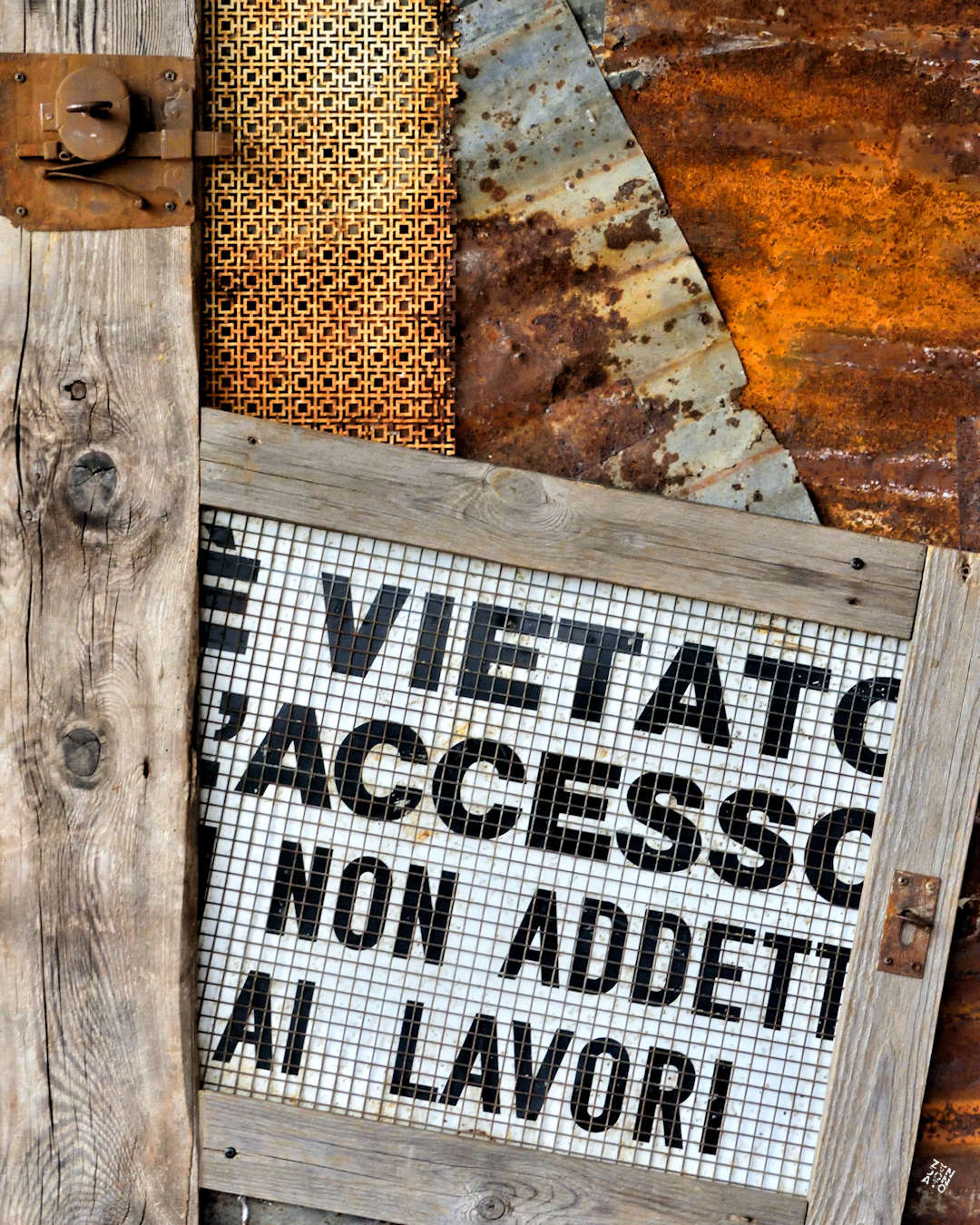
The second one is the will of the other person to want to recover himself and for this to trust and to use the help of another person: without this presupposition no door can be open.
BZanconato (who is pharmacist also) cites me many cases in which these discomforts of the human soul have been and still are seen as illnesses to treat pharmacologically. "In my opinion, it's not with a molecule administered in determined concentrations as it's not to distractedly listen to the stories that you can enter the depth of the human heart and you can extract the pains that more have marked it: only if this current of energy, that I called empathy or love, is established the process of recovery can start. If these conditions aren't verified, the thing doesn't work and the doors of the heart stay blocked. "
When I move my eyes on the artwork I understand, at least partly, the meaning of the words of the artist: the artwork is as a sort of metallic door with two locks and a sign points out the "prohibition of access to not employees", in which the oxidized surfaces transmit the feeling of a long departed time without it has been open. It’s the representation of a long imprisonment in an abandoned place, almost forgotten: exactly, the heart of the heart, that is the most intimate place of the soul. As it expressly says the sign, the access is strictly forbidden to not employees. The artwork transmits me a sense of desolation and deep loneliness. I understand the sense of the words I have just heard: only a deep love gesture can allow to access that place and the opening of that door.
The artist continues: "I believe that the central point of this, that I define love, is the sincere attention that brings us to acknowledge the other. It's to give energy to take care of and to grow… to recover the inherent seed in every person so it can develop, can bloom and can scatter, in turn, its scent in the world enriching it. This because every being comes to the world to bring something. When a single person doesn't succeed in developing himself, he impoverishes the world since he deprived it of his personnel and unique contribution. For this, especially in these times, it's important to recover this aspect…
The key point is the vision that the human being doesn't exhaust him in his physical part: besides his body another dimension exists (that we can define soul, spirit, mind, psyche,..). We have to keep in account it because it speaks to us through feelings and states of mind. When the perspective of a spiritual component is welcomed as another fundamental part of every person, then it change, first of all the perspective of himself, but then also that of the world and of the things that surround us. Accordingly you abandon the logic of the possession, of the fact that each one is what he owns (many common behaviors are still founded on this assumption) and you enter the perspective of being. Or, perhaps still better, of becoming, because everything changes and it asks for a continuous adaptation."
BZanconato (who is pharmacist also) cites me many cases in which these discomforts of the human soul have been and still are seen as illnesses to treat pharmacologically. "In my opinion, it's not with a molecule administered in determined concentrations as it's not to distractedly listen to the stories that you can enter the depth of the human heart and you can extract the pains that more have marked it: only if this current of energy, that I called empathy or love, is established the process of recovery can start. If these conditions aren't verified, the thing doesn't work and the doors of the heart stay blocked. "
When I move my eyes on the artwork I understand, at least partly, the meaning of the words of the artist: the artwork is as a sort of metallic door with two locks and a sign points out the "prohibition of access to not employees", in which the oxidized surfaces transmit the feeling of a long departed time without it has been open. It’s the representation of a long imprisonment in an abandoned place, almost forgotten: exactly, the heart of the heart, that is the most intimate place of the soul. As it expressly says the sign, the access is strictly forbidden to not employees. The artwork transmits me a sense of desolation and deep loneliness. I understand the sense of the words I have just heard: only a deep love gesture can allow to access that place and the opening of that door.
The artist continues: "I believe that the central point of this, that I define love, is the sincere attention that brings us to acknowledge the other. It's to give energy to take care of and to grow… to recover the inherent seed in every person so it can develop, can bloom and can scatter, in turn, its scent in the world enriching it. This because every being comes to the world to bring something. When a single person doesn't succeed in developing himself, he impoverishes the world since he deprived it of his personnel and unique contribution. For this, especially in these times, it's important to recover this aspect…
The key point is the vision that the human being doesn't exhaust him in his physical part: besides his body another dimension exists (that we can define soul, spirit, mind, psyche,..). We have to keep in account it because it speaks to us through feelings and states of mind. When the perspective of a spiritual component is welcomed as another fundamental part of every person, then it change, first of all the perspective of himself, but then also that of the world and of the things that surround us. Accordingly you abandon the logic of the possession, of the fact that each one is what he owns (many common behaviors are still founded on this assumption) and you enter the perspective of being. Or, perhaps still better, of becoming, because everything changes and it asks for a continuous adaptation."
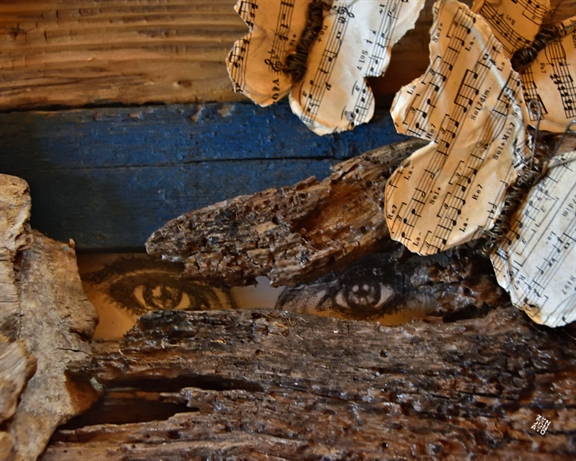
While she is still speaking, she takes me toward another artwork "MOKSHA" (Sanskrit word that means liberation) that faces the subject of possession. "I have thought how many demonstrations and practices of possession (in this case, the possession of the woman's body) still remain as heritages of the past or, still better, of a retrograde mentality that sees the human being only in its physical component: the body. Body becomes a property to own. Suits, mutilating practices, … are nothing but jails in which to hold in guarded deposit the female body, her man's property.
And feminicides are nothing but the tragic results of this mentality that, deceitfully, is passed on from generation to generation. But what is imprisoned?
Thinking about these things, by contrast, a passage of E. Hillesum has come to my mind: «..When Hanneke said, speaking of " constraints" and "bonds: "No, I could not live without bonds, without a husband, without children, no, simply I would not be able", ", at that moment I have immediately understood what my internal reaction to her words could be, and that is
And feminicides are nothing but the tragic results of this mentality that, deceitfully, is passed on from generation to generation. But what is imprisoned?
Thinking about these things, by contrast, a passage of E. Hillesum has come to my mind: «..When Hanneke said, speaking of " constraints" and "bonds: "No, I could not live without bonds, without a husband, without children, no, simply I would not be able", ", at that moment I have immediately understood what my internal reaction to her words could be, and that is
more or less this one: "Yes, I could live so, I would be also able, perhaps, to withstand for a long time in a bare cell, for years knelt on a hard floor, I would have a great and luxuriant life however: everything that life can offer would be inside of me... »
And it’s really her awareness, that is the existence of something that goes over our body, that has allowed Etty Hillesum to find the energy to bear life in the concentration camp in which she voluntarily entered for helping people."
BZanconato explains that has tried to put in evidence the existence of the human soul, that cannot be owned neither caged by other people, in spite of everything.
Looking at the artwork while I am listening to her words, I perceive the contrast among the sense of freedom, almost of joy, of the butterflies and that of imprisonment of the figure we can glimpse beyond that sort of paling, constituted by the different wooden elements. Moreover, it strikes me the look of this figure: its sight opens on the outside, free as the soul of which those eyes are the mirror.
This connects the following artwork "THE EAGLE'S SIGHT". It symbolizes this new awareness, this new perspective that is made ampler by the perception of the soul. The eagle, raising itself in the sky more than every other bird, has the ability to widen its vision and to gather the whole things.
And it’s really her awareness, that is the existence of something that goes over our body, that has allowed Etty Hillesum to find the energy to bear life in the concentration camp in which she voluntarily entered for helping people."
BZanconato explains that has tried to put in evidence the existence of the human soul, that cannot be owned neither caged by other people, in spite of everything.
Looking at the artwork while I am listening to her words, I perceive the contrast among the sense of freedom, almost of joy, of the butterflies and that of imprisonment of the figure we can glimpse beyond that sort of paling, constituted by the different wooden elements. Moreover, it strikes me the look of this figure: its sight opens on the outside, free as the soul of which those eyes are the mirror.
This connects the following artwork "THE EAGLE'S SIGHT". It symbolizes this new awareness, this new perspective that is made ampler by the perception of the soul. The eagle, raising itself in the sky more than every other bird, has the ability to widen its vision and to gather the whole things.
BZanconato underlines that "The awareness of your own soul determines a change of vision: from a small perspective, that of possession, to that ample of the being/eagle in which it's possible not only to gather your own development path, that from the seed brings you to bud the flower, but also that this process involves everybody and everything.
This new perspective reveals the flow of life in which everybody is immersed. At the moment in which a person acquires this awareness, he also knows that he has to follow his own way of development and at the same time, if possible, to favor that of others.
To reach this awareness there are not masters and courses to follow: if, on one side, they can point out a direction, on the other, the only way to reach the deep understanding is experimenting, directly trying, learning from the experiences and living the entire life with everything it provides, whether in positive sense or in negative. To experiment life you need however to have some projects, to have the desire to try for widening your own experiences and knowledges because, after all, desire is life.
This new perspective reveals the flow of life in which everybody is immersed. At the moment in which a person acquires this awareness, he also knows that he has to follow his own way of development and at the same time, if possible, to favor that of others.
To reach this awareness there are not masters and courses to follow: if, on one side, they can point out a direction, on the other, the only way to reach the deep understanding is experimenting, directly trying, learning from the experiences and living the entire life with everything it provides, whether in positive sense or in negative. To experiment life you need however to have some projects, to have the desire to try for widening your own experiences and knowledges because, after all, desire is life.
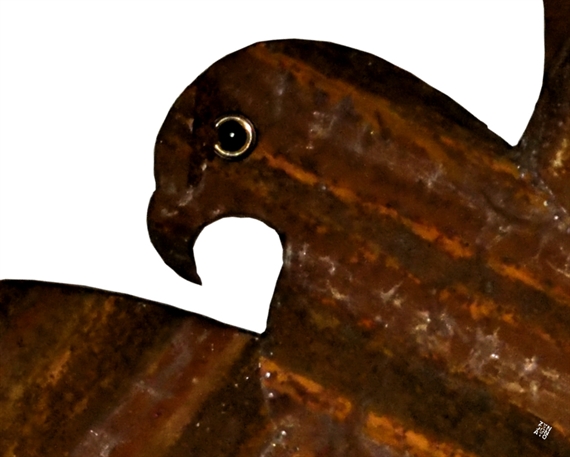
But for many desire, to aim for something, as a consequence of the scarce love for themselves, it's not an important thing. For me, instead, it's fundamental, because it's, after all, to promote that desire of expansion, of growth, that is inherent us and, if we understood it in its essence, it would lead us towards the flowering.”
She takes me to the next artwork "THE LIGHT SIDE" or better to a part of the work that, being an installation, will be composed in the exhibition. The artist foresees the involvement of the spectators that will have the possibility to write their own desires on pieces of paper that, then, will belong to the installation. The purpose is multiple: on one side, to invite people to a small phase of meditation because, to define and to point out their own desires, she will bring them to a first reflection about themselves. "On the other - the artist adds - to pass the concept that world, the universe, is much richer than our blinkers allow us to see. To express desires is an important act. It can be difficult to accept but if you paid the due attention and you gathered the events in the correct light, you would see that what you desired, if consistent with your growing process, with unpredictable times and ways it will come true. These two aspects, that is the fact that you can not to be able to foresee how and when the desires will come true, they will make you aware, once experimented, of the wealth of the world (and also of how many opportunities you often lose because of your limited vision of things)."
She takes me to the next artwork "THE LIGHT SIDE" or better to a part of the work that, being an installation, will be composed in the exhibition. The artist foresees the involvement of the spectators that will have the possibility to write their own desires on pieces of paper that, then, will belong to the installation. The purpose is multiple: on one side, to invite people to a small phase of meditation because, to define and to point out their own desires, she will bring them to a first reflection about themselves. "On the other - the artist adds - to pass the concept that world, the universe, is much richer than our blinkers allow us to see. To express desires is an important act. It can be difficult to accept but if you paid the due attention and you gathered the events in the correct light, you would see that what you desired, if consistent with your growing process, with unpredictable times and ways it will come true. These two aspects, that is the fact that you can not to be able to foresee how and when the desires will come true, they will make you aware, once experimented, of the wealth of the world (and also of how many opportunities you often lose because of your limited vision of things)."

This is the meaning of "LET IT BE" the next artwork that BZanconato foresees in the show. To desire, to intensely live your life is a fundamental part to reach the awareness and the perspective of the eagle.
Nevertheless, you have to avoid the conceitedness to have everything under control. She specifies: "If we leave that things flow and if we set the correct attention, our desires, often in unexpected ways, they come true. Then amazement gathers you and at the same time a feeling pervades you: to be a part of everything. This definitely sends away that sense of loneliness that makes you feel small and alone in struggle against the world.
It's a feeling that reverses the perspective and that makes you to perceive the harmony with yourself and with the world. You are, then, automatically pushed to love in the widest sense of the word. Because love is to give attention, to take takes care of, to devote time. Because true love doesn't implicate material aspects: you give what more precious you have, that is your time (precious because limited) and your energy. When you love, that is you offer yourself, this gives you joy and makes you feel alive.
On the other side, the person that perceives this empathetic energy becomes wealthy and his growing process progresses (or it regenerates) making him, in turn, become a person potentially able to love. That's the reason because love produces love."
“PERCHE’ NE VALE LA PENA” ("Because it’s Worth", a great writing that crosses the central wall of the exhibition) it's the conclusive artwork of this journey. The show, started as a sort of personal development, ends up with a collective if not cosmic implication that embraces everybody and everything and can allow to realize the threads that tie everybody to what it's surrounding and that move everybody in a continuous flow of growth and expansion. I perceive, in the breakdown, the sense of a holistic vision in which everything assumes a depth meaning. The wealth of ideas, in the various aspects of her narration, opens a myriad of glimmers; the manifold plans of possible reading of the various artworks, besides that of the artist, are a mirror of the wealth and complexity of the world in which she wants to bring us with that empathetic trip of which she has spoken to me. It is this, perhaps, her true objective, the true message she wants to bring: a different point of view, to make reflect and to stimulate, to make to spring from each one his own interpretation because, at last, she says: “… each one has his own path to follow and nobody can show you the way: there is no manual to follow, in spite of the title "Manuale di volo" that I provocatively wanted to give to the show."
I listen to these last words and I am deeply stricken…
Nevertheless, you have to avoid the conceitedness to have everything under control. She specifies: "If we leave that things flow and if we set the correct attention, our desires, often in unexpected ways, they come true. Then amazement gathers you and at the same time a feeling pervades you: to be a part of everything. This definitely sends away that sense of loneliness that makes you feel small and alone in struggle against the world.
It's a feeling that reverses the perspective and that makes you to perceive the harmony with yourself and with the world. You are, then, automatically pushed to love in the widest sense of the word. Because love is to give attention, to take takes care of, to devote time. Because true love doesn't implicate material aspects: you give what more precious you have, that is your time (precious because limited) and your energy. When you love, that is you offer yourself, this gives you joy and makes you feel alive.
On the other side, the person that perceives this empathetic energy becomes wealthy and his growing process progresses (or it regenerates) making him, in turn, become a person potentially able to love. That's the reason because love produces love."
“PERCHE’ NE VALE LA PENA” ("Because it’s Worth", a great writing that crosses the central wall of the exhibition) it's the conclusive artwork of this journey. The show, started as a sort of personal development, ends up with a collective if not cosmic implication that embraces everybody and everything and can allow to realize the threads that tie everybody to what it's surrounding and that move everybody in a continuous flow of growth and expansion. I perceive, in the breakdown, the sense of a holistic vision in which everything assumes a depth meaning. The wealth of ideas, in the various aspects of her narration, opens a myriad of glimmers; the manifold plans of possible reading of the various artworks, besides that of the artist, are a mirror of the wealth and complexity of the world in which she wants to bring us with that empathetic trip of which she has spoken to me. It is this, perhaps, her true objective, the true message she wants to bring: a different point of view, to make reflect and to stimulate, to make to spring from each one his own interpretation because, at last, she says: “… each one has his own path to follow and nobody can show you the way: there is no manual to follow, in spite of the title "Manuale di volo" that I provocatively wanted to give to the show."
I listen to these last words and I am deeply stricken…